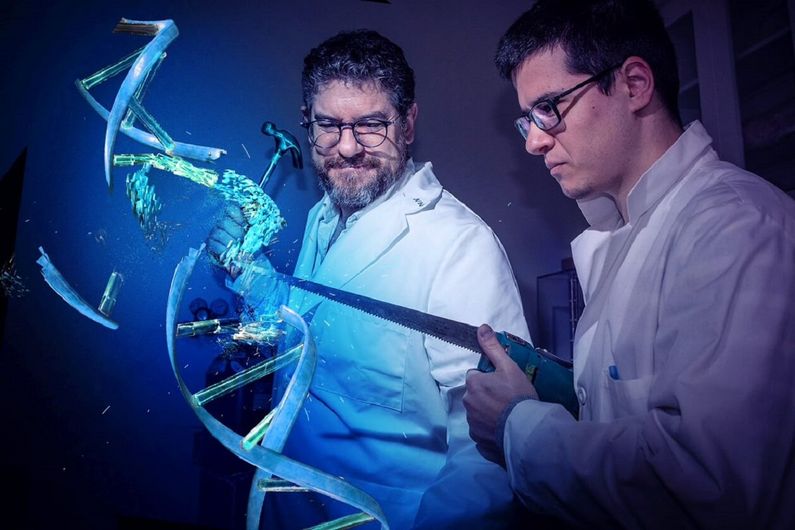I associate the idea of ‘creative destruction’ with economics and Joseph Schumpeter but it is more widespread and has a much longer history (see more at the end of this posting).
Here we have Université de Montréal researchers being inspired by the idea from (what was to me) an unexpected source, from a February 9, 2023 news item on Nanowerk,
“Every act of creation,” Picasso famously noted, “is first an act of destruction.”
Taking this concept literally, researchers in Canada have now discovered that “breaking” molecular nanomachines basic to life can create new ones that work even better.
…
I love this image. Bravo!

A February 9, 2023 Université de Montréal news release, which originated the news item, delves further into this act of creative destruction,
Evolved over millions of years
Life on Earth is made possible by tens of thousands of nanomachines that have evolved over millions of years. Often made of proteins or nucleic acids, they typically contain thousands of atoms and are less than 10,000 times the size of a human hair.
“These nanomachines control all molecular activities in our body, and problems with their regulation or structure are at the origin of most human diseases,” said the new study’s principal investigator Alexis Vallée-Bélisle, a chemistry professor at Université de Montréal.
Studying the way these nanomachines are built, Vallée-Bélisle, holder of the Canada Research Chair in Bioengineering and Bio-Nanotechnology, noticed that while some are made using a single component or part (often long biopolymers), others use several components that spontaneously assemble.
“Since most of my students spend their lives creating nanomachines, we started to wonder if it is more beneficial to create them using one or more self-assembling molecular components,” said Vallée-Bélisle.
A ‘destructive’ idea
To explore this question, his doctoral student Dominic Lauzon, had the “destructive” idea of breaking up some nanomachines to see if they could be reassembled. To do so, he made artificial DNA-based nanomachines that could be “destroyed” by breaking them up.
“DNA is a remarkable molecule that offers simple, programmable and easy-to-use chemistry,” said Lauzon, the study’s first author. “We believed that DNA-based nanomachines could help answer fundamental questions about the creation and evolution of natural and human-made nanomachines.”
Lauzon and Vallée-Bélisle spent years performing the experimental validations. They were able to demonstrate that nanomachines could easily withstand fragmentation, but more importantly, that such a destructive event allowed for the creation of various novel functionalities, including different sensitivity levels towards variation in component concentration, temperature and mutations.
What the researchers found is that these functionalities could arise simply by controlling the concentration of each individual component. For example, when cutting a nanomachine in three components, nanomachines were found to activate more sensitively at high concentration of components. In contrast, at low concentration of components, nanomachines could be programmed to activate or deactivate at specific moment in time or to simply inhibit their function.
“Overall, these novel functionalities were created by simply cutting up, or destroying, the structure of an existing nanomachine,” said Lauzon. “These functionalities could drastically improve human-based nanotechnologies such as sensors, drug carriers and even molecular computers”.
Evolving new functionalities
Just as Picasso typically destroyed dozens of unfinished works to create his famous artworks, and just like muscles need to break down to get stronger, and innovative new companies are born by eliminating older competitors from the market, nanoscale machines can evolve new functionalities by being taken apart.
Unlike common machines like cell phones, televisions and cars, which are made by combining components using screws and bolts, glue, solder or electronics, “nanomachines rely on thousands of weak dynamic intermolecular forces that can spontaneously reform, enabling broken nanomachines to re-assemble,” said Vallée-Bélisle.
In addition to providing nanotechnology researchers with a simple design strategy to create the next generation of nanomachines, the UdeM team’s findings also shed light on how natural molecular nanomachines may have evolved.
“Biologists have recently discovered that about 20 per cent of biological nanomachines may have evolved through the fragmentation of their genes,” said Vallée-Bélisle. “With our results, biologists now have a rational basis for understanding how the fragmentation of these ancestral proteins could have created new molecular functionalities for life on Earth.”
Here’s a link to and a citation for the paper,
Functional advantages of building nanosystems using multiple molecular components by D. Lauzon & A. Vallée-Bélisle. Nature Chemistry volume 15, pages 458–467 (2023) DOI: https://doi.org/10.1038/s41557-022-01127-4 Published online: 09 February 2023 Issue Date: April 2023
This paper is behind a paywall.
Creative destruction
The Wikipedia entry for ‘Creative destruction’ is primarily on economic theory and various philosophies with no mention of Picasso. However, there is a fascinating segue into Eastern mysticism,
Other early usage
…
Hugo Reinert has argued that Sombart’s formulation of the concept was influenced by Eastern mysticism, specifically the image of the Hindu god Shiva, who is presented in the paradoxical aspect of simultaneous destroyer and creator.
…
On that note, have a lovely weekend.